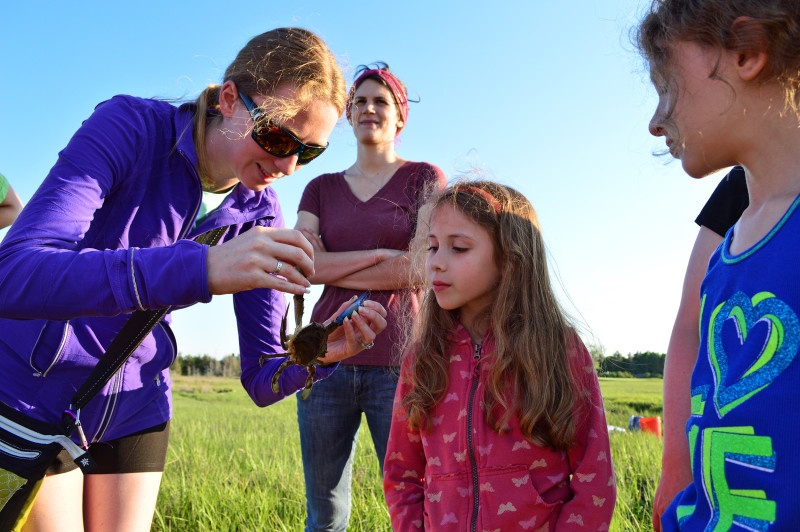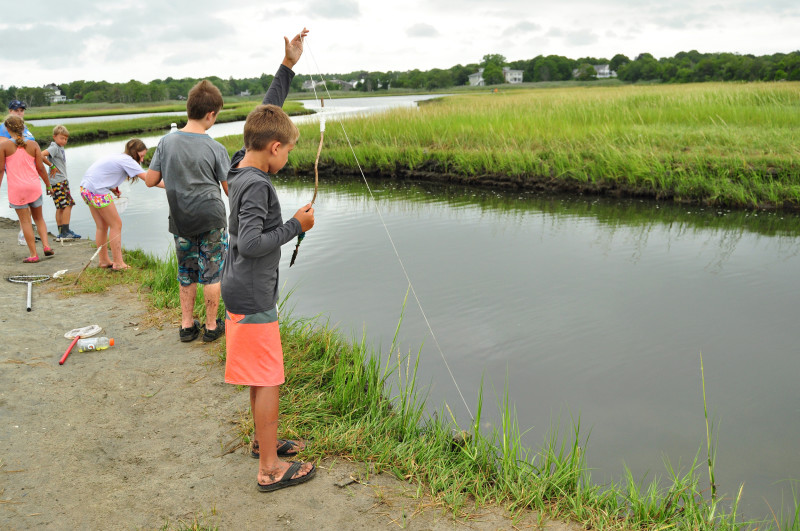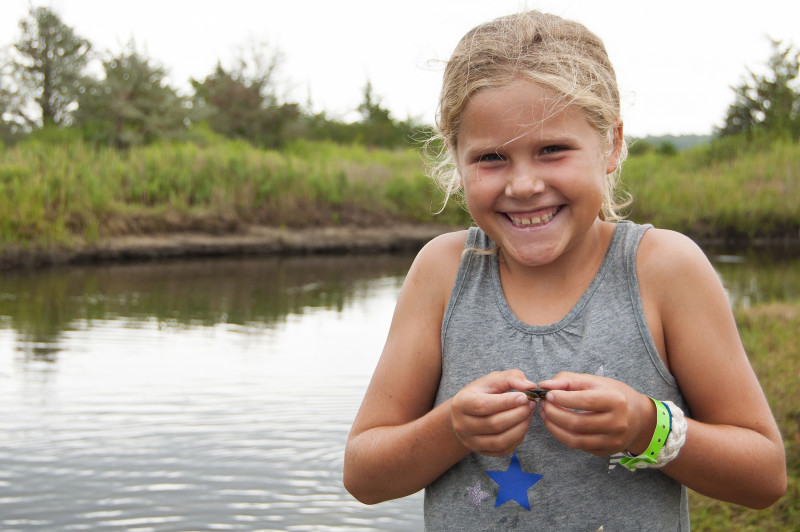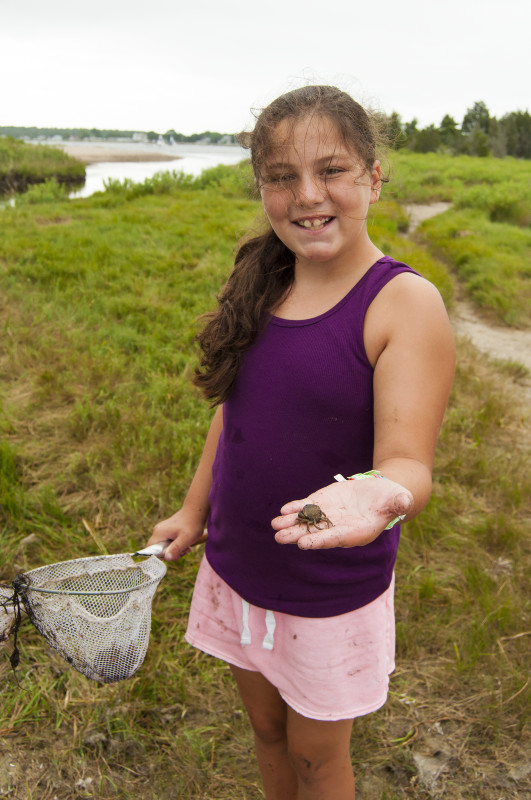How to catch blue crabs in Buzzards Bay with your kids
If you’re looking for a fun, easy, and inexpensive activity to do with your kids, then we have one word for you: crabbing!
Blue crabs are feisty (and delicious!) swimming crabs that live in shallow, marshy areas in Buzzards Bay’s brackish rivers, estuaries, and tidal creeks. Catching them is relatively simple, and it doesn’t require a lot of special equipment. Plus, crabbing is great way to connect your family with the water and explore what lives in the Bay.
Here’s everything you need to know about crabbing with your kids in Buzzards Bay:
What are blue crabs?

Blue crabs are swimming crustaceans that live in Buzzards Bay’s rivers and estuaries. They’re feisty, but fun and easy to catch!
The blue crab, Callinectes sapidus, is a swimming crab that’s found up and down the East Coast, from Nova Scotia all the way to the Gulf of Mexico, the Caribbean, and even South America. Blue crabs are crustaceans, which means they have an exoskeleton that they shed to grow. Crabs, lobsters, shrimp, crayfish, and even barnacles are all crustaceans.
Although they’re called “blue” crabs, their shell (also called the carapace) is usually more of an olive green color. It’s their claws and legs that are bright, brilliant blue. Females have red-tipped claws, which is one fun way to tell the difference between males and females – another is by the shape of their abdomen.
There’s reason why blue crabs are called “beautiful swimmers”: their rear legs are shaped like paddles, which allows them to swim gracefully through the water. And they are quick – especially when you’re trying to catch one!
Blue crabs are also known for being fairly aggressive. Their pointy claws pack quite a pinch, so take care when you’re handling them. The best way to hold a crab is from behind, where their claws can’t reach your hand.
Blue crabs are famous in places like the Chesapeake Bay, where commercial fishermen harvest millions of pounds of crabs each year. Blue crabs are also caught commercially in places like Florida and Louisiana. But Buzzards Bay has plenty of blue crabs of its own waiting for you to find!
What do you need to go crabbing?

You only need a few simple, inexpensive supplies to catch blue crabs. With just a line and some bait, you’re ready to go crabbing!
It’s simple to get started catching blue crabs. With just a few inexpensive supplies, you’ll be ready to spend a few fun hours out on the Bay crabbing with your kids.
- Trap: First, you need something to catch those crabs in! Pick up a couple of small, collapsible crab traps like a ring net or a pyramid trap. These traps run less than $10 apiece at local and online retailers.
- Line: If you don’t have a trap, you can actually go crabbing without one. You can catch crabs with a simple drop line, which is nothing more than some fishing line with a piece of bait tied to the end. If you see a crab or feel a tug on the line, pull it in slowly until you can reach it with your net.
- Bait: Speaking of bait, you’ll need something to lure those crabs in. Raw chicken necks and drumsticks are the most popular blue crab bait. Hot dogs also work well. For about $5 or less, you can get enough bait to last you the whole day!
- Net: Have a long-handled dip net ready to scoop your crabs out of the water or the trap. Be quick, because crabs will swim away fast! Your kids can also use these nets to explore around the shoreline for other types of crabs, fish, plants, and grass shrimp.
- Empty water bottle or stick: Tie the end of your line to an empty water bottle, which is easier for kids to hold on to. Plus, it’ll float if they accidentally drop the line in the water! You can also tie your line to a stick instead, which makes it easy to stick your line in the mud while you wait for a bite.
- Ruler: If you’re planning to keep your crabs – you can keep up to 25 per day, according to Massachusetts recreational crab regulations – you’ll need a ruler to measure each crab. You can only keep crabs that are 5 inches across from spine to spine. You also can’t take female crabs that have a visible egg sac, which looks like a yellow sponge on their abdomen.
- Bucket: Bring along a large bucket to store your catch while you crab. Even if you don’t keep anything, it’s still fun to see all the species you caught before you let them go!
- Other supplies: If you’re afraid of getting pinched, consider purchasing crab tongs or gloves, which will help protect your hands.
Unlike quahogging, crabbing doesn’t require a permit if you’re a casual crabber using a simple collapsible trap or a drop line. The season is open from May 1 to December 31, but the best time to find blue crabs around Buzzards Bay is in the summer.
Where can you go crabbing in Buzzards Bay?

Kids (and their parents) will be amazed by the wildlife you can find in the salt marsh along Eel Pond, just behind Shining Tides Beach in Mattapoisett.
The key to successful blue crabbing is picking the right spot. Blue crabs live in brackish waters, where fresh water mixes with salt water from Buzzards Bay. They don’t like water that’s too salty, which is why you won’t normally see them at your local Bay beach.
Look for blue crabs in shallow, marshy rivers, estuaries, and creeks that flow toward the Bay. You can catch blue crabs from any spot along the water: boat, a dock or a pier, or straight from the edge of the shore.
A few places we love to find blue crabs are Eel Pond at Shining Tides Beach in Mattapoisett and the Lyman Reserve in Plymouth/Bourne/Wareham. Other spots we’ve heard are great for crabbing are the Westport Rivers, the Weweantic River, the Pocasset River, and the Agawam River and Wareham River.
You should also look at the tides when you’re planning your crabbing adventure. It’s best to go near high tide – particularly an hour before or after, when the water is moving in or out. You’ll have the most luck catching crabs when there’s a nice current moving as the tide ebbs and flows.
What other types of crabs can you catch in Buzzards Bay?

Even if you don’t catch any blue crabs, your kids will have a blast crabbing and exploring life in the water.
While you’re out crabbing, you might find a few different types of crabs, especially if your kids start exploring the shoreline with their nets. That’s another reason why crabbing is such a fun activity to do with kids: it’s an opportunity to discover the variety of life living in our local waters.
- Asian shore crab: The small, mottled brown Asian shore crab lives along the shore near shallow waters. It’s native to Asia, but has established itself on the East Coast from Maine to North Carolina.
- Green crab: The green crab is another invasive species that is native to Europe. Like their name implies, green crabs are greenish in color. They live in similar places as blue crabs as well as on rocky and muddy shores.
- Spider crab: With eight long, spindly legs and a spiny shell, spider crabs really do look like spiders! Spider crabs are found throughout Buzzards Bay, from rocky shores to eelgrass beds. If you keep winding up with spider crabs in your blue crab traps, that’s a sign that the water might be too salty for blue crabs. Head further away from the salt water, and you might have better luck.
- Hermit crabs: If you’re crabbing from the shore, you’ll likely find a few hermit crabs in your catch. Hermit crabs are very common on our local beaches and salt marshes. These little crabs don’t grow their own shells, so they have to “borrow” an empty shell. Your kids will have fun looking at all the different shells hermit crabs live in!
Even if you don’t catch any blue crabs, your whole family will still have a fun day getting wet and muddy exploring the Bay!